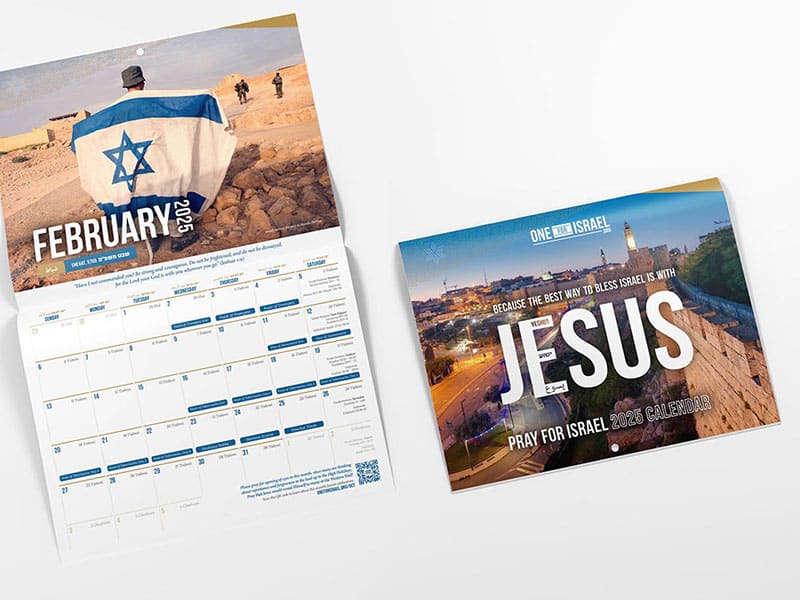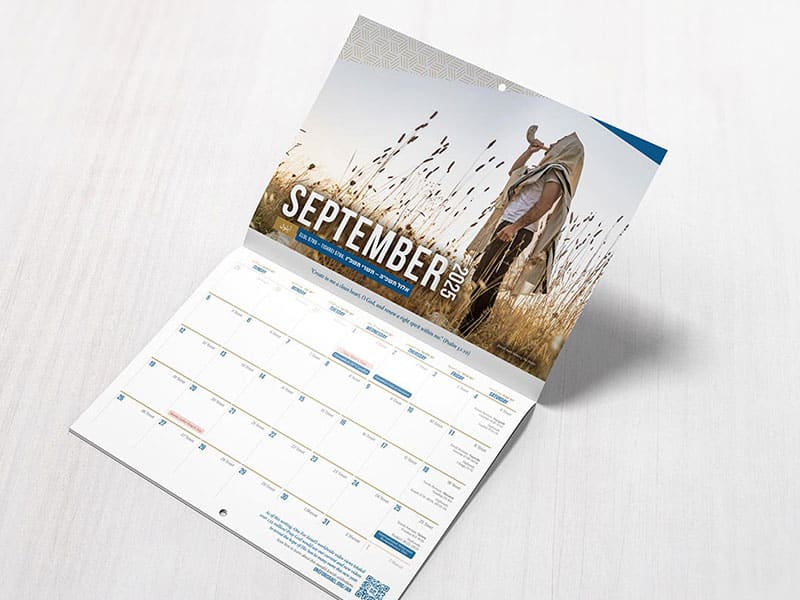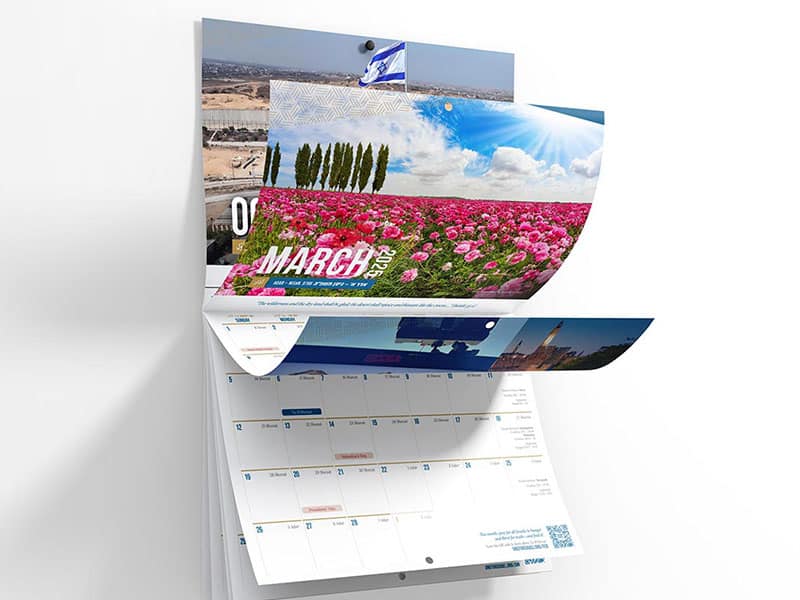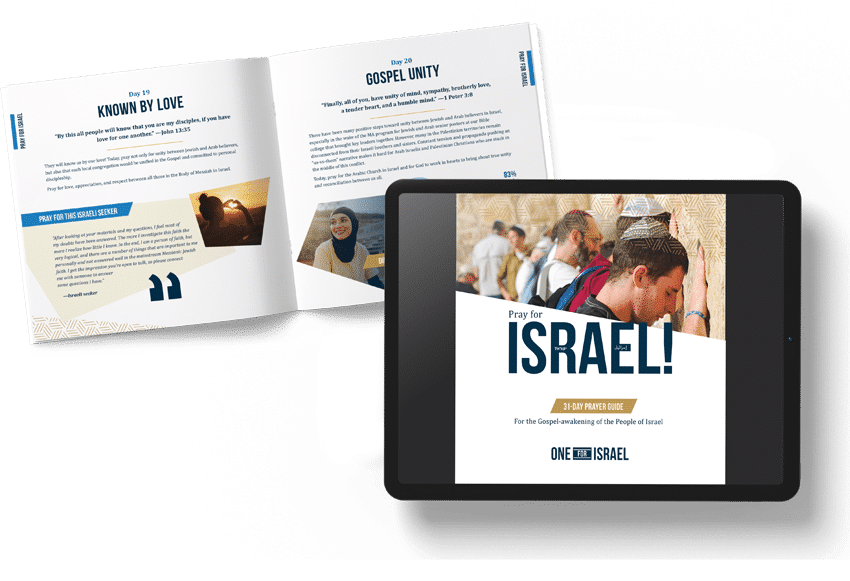God commanded His people: Have a feast! Take a break! He made festivals part of the Law, codifying the commandments to stop for a while and celebrate a few times a year.
Of course, there’s more to it than just food and merriment (although there’s plenty of that) but there’s deep prophetic meaning woven into the tapestry of God’s mandated feasts. In ingenious ways, God created fun, experiential reminders of important milestones along the journey of redemption. But as well as marking the history between God and His people, these milestones go way into the future too.
Today, as people are beginning to think more about the second coming of Jesus, it’s worth remembering that the feasts not only speak of Yeshua’s first coming, but also His triumphant return. It’s a great time to look again in earnest at the information God has given us in the calendar He set for His people.
Dates with destiny
The first thing to talk about is the word for feast used in Hebrew. The word for “feast” is moed (מועד). This word is based on a very important root word, יעד. In general, we say that moed means “appointed time”, or set feast. But there is more to it. There is certainly a sense of destiny associated with the word, but the word is also used to talk about time: everlasting, like “Everlasting Father” (Isaiah 9:6). It also means “until”. There’s another associated meaning in the word עד: it is the Hebrew word for “witness”. In court a witness gives testimony to what they have seen and heard, telling something to the people listening about something they have not experienced. The witness testifies and points to something that isn’t present, but has to be explained. So all together, the word for feast, moed, means a fixed appointed time of destiny which testifies and points to something that goes backwards and forwards through eternity.
Isn’t that a perfect description of what God gives us in the biblical feasts?!
Woah! Slow down there
Other Hebrew words for the feasts are mikra (מקרא) and atsera (עצרה). Mikra is often translated as “holy convocation”, and it means to call people together. It is also one of the words we use in Hebrew for “Bible”, because it has to do with the word for reading as well as calling. The second word, often translated as “solemn assembly”, is the word to stop. Today in Israel you’ll see it on buses, showing where the next stop is. It has to do with stopping activity, or being restrained.
Leviticus 23 gives us a clear rundown of all of these feasts that God established and commanded the Israelites to keep. They all are extremely rich with prophetic meaning.
The first moed listed is the Shabbat. In Ezekiel 20:12 God says that the Shabbat is a sign between Him and His people, a holy day which serves as a reminder that He has set us aside to be a holy people. The pause each week reminds us that it’s God who created the world and the seven day week, and Jesus says that the Shabbat was created for our benefit. The rest from work helps us relate in a more healthy way to God, our families, our environment and ourselves. Hebrews chapter 4 also explains that it is a witness to the rest that Jesus would bring through His work at calvary. Now He has finished His work, and is seated at the right hand of the Father (Hebrews 10:12). Thanks to Yeshua, we can enter perfect rest with God with Him. The Shabbat testifies to what Jesus did when He paid for our sin, and also what we have to look forward to when He returns in glory.
Another interesting thing about the Shabbat is that God made seven days in the week. He could have chosen any number, but He chose seven. Many of the times and seasons mentioned in Genesis chapter one are obvious to both humans and animals alike – nature knows the difference between night and day, spring, summer, fall and winter… and even months going by as the moon changes shape. But the days of the week? Only human beings know which day of the week it is – no animal knows whether it’s Shabbat or not! The seven day week and the weekend was created by God for us. The whole world keeps to this pattern, this seven days of completion, and this is also significant, as we shall see.
The Spring Feasts
Then the next set of feasts come in the Spring, and are all related to one another:
In Exodus 12, God instructs the Israelites to start the calendar in the first month, which is now known as Nisan in the Spring.
“This month will mark the beginning of months for you; it is to be the first month of the year for you. Tell all the congregation of Israel that on the tenth day of this month, each man is to take a lamb for his family, one lamb for the household… Your lamb is to be without blemish, a year old male. You may take it from the sheep or from the goats. You must watch over it until the fourteenth day of the same month. Then the whole assembly of the congregation of Israel is to slaughter it at twilight.”
“The blood will be a sign for you on the houses where you are. When I see the blood, I will pass over you.”
When we think of the events of the Passover and the Exodus from Egypt, it’s hard to think of a more perfect picture for what was to come in Jesus! An innocent lamb without flaws was sacrificed, and the blood smeared on wood vertically and horizontally so that people who believed would be saved from death. Hammering the point home, Jesus was tested and found innocent, then He was beaten and betrayed, before his sacrifice for us on the wooden cross at exactly the time Passover lambs were being checked and slaughtered. The picture is crystal clear.
“Get rid of the old hametz [leaven], so you may be a new batch, just as you are unleavened—for Messiah, our Passover Lamb, has been sacrificed.” (1 Corinthians 5:7)
Then the people, after being redeemed by blood, passed through water and went on a long, hard journey before they finally arrived in the Promised Land. Similarly, after receiving salvation through the blood of Jesus, the Lamb of God who took away the sin of the world, we go through the waters of baptism and walk with God through hardships until we finally arrive in the place prepared for us.
After the night of Passover itself, we enter the Feast of Unleavened Bread which lasts for seven days. This is a picture of our lives as believers here on earth, choosing to turn our back on sin, with leaven (hametz) being symbolic of sin. The unleavened bread also points to Jesus – matzoh bread is striped and pierced, just as He was, and with no trace of leaven which represents sin and pride.
The 14th of Nisan, the night of the Passover, falls on different days of the week each year, but we are told that the Feast of Firstfruits must always be celebrated on the first SUNDAY after Passover (Leviticus 23:15). This feast is unique in that it fixes the day of the week – of course it points to resurrection Sunday, as a prophetic witness to the day when Jesus gained victory over death. It is also unusual because although there are other sacrifices mentioned, there is no sin offering required for the festival of Firstfruits. Jesus was the first to rise again from the dead, never to die again, but He will not be the last! At the end of time, we will all join Him and have glorious, new resurrection bodies. We will all be changed, in the twinkling of an eye (1 Corinthians 15:52).
Then from that Sunday, God commands that His people should count seven weeks to the Feast of Weeks, Shavuot in Hebrew, which means weeks (Leviticus 23:16). This festival is also known as Pentecost, with pente meaning 50, because it’s 50 days since the Feast of Firstfruits. Pentecost is the time when God poured out His Holy Spirit on the believers, giving them His power to live a new life in the Messiah and take the gospel all over the world. Shavuot testifies to the gathering and inclusion of the Gentiles into the New Covenant.
These Spring feasts are all connected and dependent on each other, and the basis and foundation is the blood of the lamb. All the other Spring Feasts depend on when the night of Passover falls. Unleavened bread follows the Passover seder, and Firstfruits falls on whichever Sunday comes next… and Shavuot is counted seven weeks from then. But it all hinges on that night of blood on the doorframes. Eating the unleavened bread of a repentant lifestyle is no use without the salvation of blood. The Passover and the redemption of blood must come first, and is followed by the equipping of the Spirit to help us walk out our new lives in Him.
So all these Spring Feasts have been fulfilled in many ways in the first coming of Jesus.
The Fall Feasts
Then there is a long gap before the next festivals in the fall. This gap between the Spring feasts and the fall feasts is not dependent on wherever Shavuot ended up, but rather starts on the first day of seventh month, which means the gap between them varies and is of uncertain length, year to year. This testifies of our experience of waiting, living in expectation of the trumpet call which will announce the return of King Jesus.
The Feast of Trumpets is called Yom Teruah in Hebrew, which means a loud noise, or blast of the horn, rather than trumpet exactly. We learn in Thessalonians that there will be a great trumpet sound to usher in the return of the Messiah. Although Jesus opened the door of redemption 2000 years ago, God has yet to ultimately redeem all things to Himself as He promised He would do in the Age to Come.
Ten days later, on the tenth day of the seventh month, we have Yom Kippur – the Day of Atonement. The number ten signifies God’s claim for perfect obedience (think of the 10 commandments). In this special day of national repentance and sacrifice, the claims of God are met and the conscience of the people is cleared. It’s a time of affliction and humbling, repentance and cleansing. In ancient Israel on Yom Kippur, the high priest entered in alone, but Jesus, our high priest, has made a way for us to be together with Him in the holy of holies. However, those who reject the forgiveness of Jesus will have to stand before the judgement seat with no cover of atonement. Yom Kippur points towards the Day of Judgement, the great and terrible day of the Lord.
Last of all we have the Feast of Tabernacles, or Sukkot as we call it in Hebrew. After hearing Ezra the priest read the instructions about how to celebrate Sukkot after they had returned from Babylon, the people of Israel joyfully went to fulfil the command to go and build booths! God instructed His people to build shelters, or sukkot as they’re called in Hebrew, to remind us of the forty years of journeying in the desert. A week spent in a flimsy shelters reminds us of the temporary nature of this life, and points to our eternal home in the world to come.
The wheat harvest and the grape harvest are both gathered before Sukkot. Jesus speaks of good crops of wheat being like fruitful believers, and also the Bible warns us of grapes trodden down in God’s wrath. The harvesting and the sorting happen before Sukkot which is like a big harvest festival. Unlike the Feast of Unleavened Bread which is seven days long, this holiday lasts for eight days, which symbolises going beyond completion into eternity, resurrection and a new beginning. There are seven days of the feast, with an eighth day (known as shmini atzeret) of joyful rest at the end!
“So on the fifteenth day of the seventh month, when you have gathered in the fruits of the land, you are to keep the Feast of Adonai for seven days. The first day is to be a Shabbat rest, and the eighth day will also be a Shabbat rest.”
In Zechariah 2:10, God promises His people that He’s going to come and tabernacle with us, and Jesus makes it clear to us that He wants to live with us, and we with Him. In Jewish thought, a sukkah is reminiscent of a chuppa, a wedding canopy. This is another shelter that points to the ultimate wedding of the Bride and the Lamb. The ultimate rest.
This is how the calendar ends, with joyful union with God.
The feasts as witnesses and pointers
Now you might ask, with all these amazing signs that point so clearly to Jesus, why don’t Jewish people believe in Him? A large part of the answer is that the Jewish picture of the Messiah is very different to the Lamb of God, the Suffering Servant who came 2000 years ago. They were expecting a conquering king, a victorious warrior, who would usher in a Messianic age of perfection. Why did they think that? Because that is what is described over and over again in the Hebrew Scriptures – and it will happen! But many Christians don’t seem to know this side of our Messiah very well. They might know what Revelation says about the end of time, but aren’t so familiar with the hundreds of details about the Messiah’s glorious coming given to us in the Old Testament.
In the same way that the Jewish people missed the time of His visitation in the first century because they were expecting something very different, people will be in for a big shock when He comes again in glory if they’re expecting a gentle shepherd instead of a conquering King.
Where Christians see the crucifixion prophesied in the Passover, Jewish people see multiple pointers to the ultimate redemption to come.
Many seem to believe that the Spring feasts point exclusively to Yeshua’s first coming and only the Fall feasts look to his return, but there is plenty we can learn about His second coming from all of the feasts.
As each day passes we are getting nearer and nearer to the day of His return. Do you know what to expect? Do you know what the Hebrew Scriptures tell us about what will happen when the Messiah comes in glory? What we can learn from all of the Feasts of the Lord about that great and glorious day?
It’s high time to learn more about the Lion of Judah the Jewish people have been expecting generation after generation, because let me tell you, He is on His way.
















